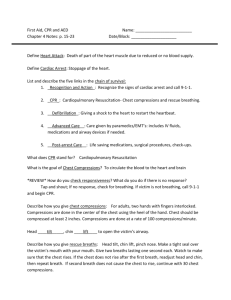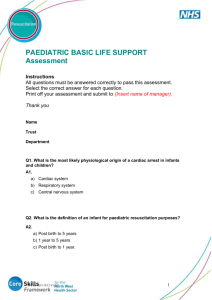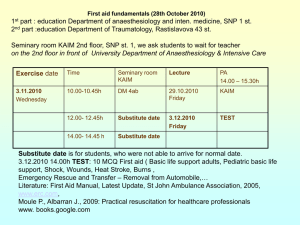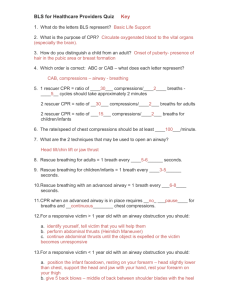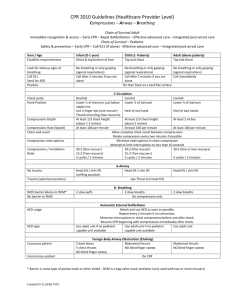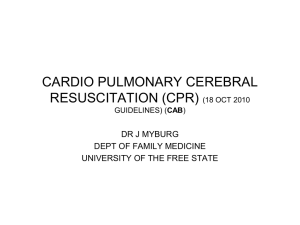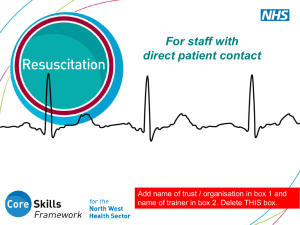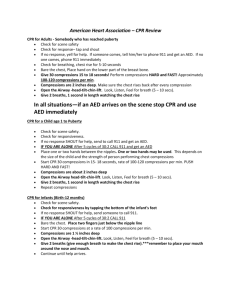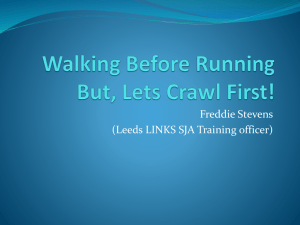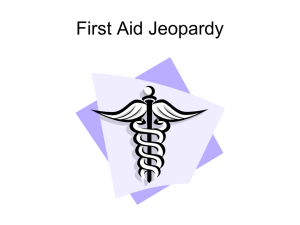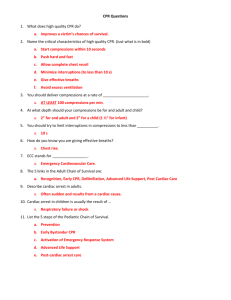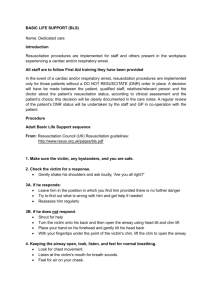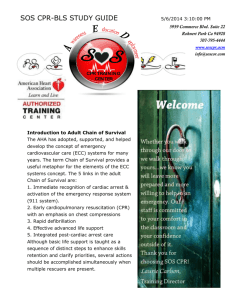Instructions to students
advertisement
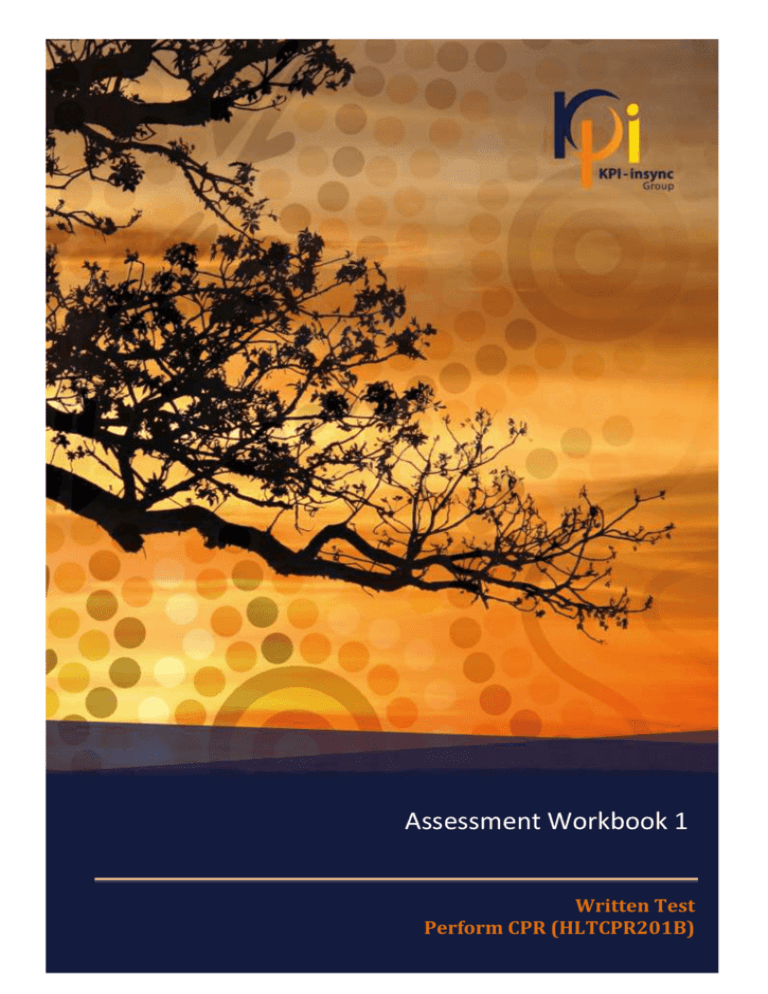
Assessment Workbook 1 Written Test Perform CPR (HLTCPR201B) Assessment - HLTCPR201B Head Office Suite 30103 Tower 3 9 Lawson Street Southport Qld 4215 Mail: P.O. Box 642 Helensvale Qld 4212 Tel: 1300 595 228 Fax: (07) 55736590 www.kpiinsync.com.au Student Name Student Signature Unit Workbook S NYS Unit Practical S NYS C NYC Final competency achieved Assessor signature Assessor name Date: Date: Assessor Comments ©KPI-Insync-HLTCPR201B/Assessment Wkbk-ID.02/12-RD02/13-V1 2 Assessment - HLTCPR201B Instructions to students Indicate your responses by circling the correct statement in this workbook This multiple choice test consists of 16 questions which need to be completed in-class at the end of the practical session. You will be allowed 30 minutes to complete this assessment. This is an open book assessment which means that you can refer to your learning notes to assist with the answers. Provide only one answer for each question. You need 100% accuracy in your answers to achieve competency in this unit of competency. If you need to resit the test, you only have to complete those activities that were deemed incorrect and you can make two further attempts to reach competency at no further cost. If you do not reach competency after two further attempts, your enrolment will be cancelled and you will be required to enrol again and pay the full course fees. Q1. Once you start First Aid Treatment you take on a ‘Duty of Care’ to provide treatment until: A. Another trained First Aider arrives and takes over B. Qualified help arrives and takes over C. You become physically unable to continue D. A, B & C are correct Q2. When Phoning for Emergency Services in Australia the correct number to dial is: A. 911 B. 111 C. 999 D. 000 Q3. As you approach a victim, what is your FIRST important consideration? A. Check if they are Breathing B. Check their Response C. Check for Danger D. Check and clear their Airway ©KPI-Insync-HLTCPR201B/Assessment Wkbk-ID.02/12-RD02/13-V1 3 Assessment - HLTCPR201B Q4. The finger sweep is a recommended process for removing foreign body airway obstruction in unconscious adults and children TRUE/FALSE Q5. The most commonly used method to open an airway for both adults and children is the head tilt and chin lift TRUE/FALSE Q6. If you had to open the airway of an infant (less than one year old) you would; A. Head tilt and chin lift as per adults and children B. Sit them up and tilt their head C. Keep the head in neutral position D. Do head tilt only Q7. In relation to the airway; laboured, noisy breathing, coughing and redness in the face are signs and symptoms of: A. Partial airway obstruction B. Complete airway obstruction C. The flu D. None of the above Q8. Signs and symptoms of a complete airway obstruction include the following; A. Laboured, noisy breathing & coughing B. Absence of breathing sounds, panic, hands on the throat C. Panic and laboured breathing D. All of the above Q9. One of the VMR crew has come up to you loudly coughing and indicating that he is choking. You can hear laboured breathing sounds so your best form of action at this point would be to encourage him to cough to try and get rid of the foreign object. TRUE/FALSE Q10. For a complete airway obstruction, whilst the patient is conscious, you can use a combination of the following A. Back blows and chest thrusts ©KPI-Insync-HLTCPR201B/Assessment Wkbk-ID.02/12-RD02/13-V1 4 Assessment - HLTCPR201B B. Chest compressions and coughing C. Back blows only D. Chest thrusts only Q11. CPR Rescue Breaths / Chest compressions ratio for all ages is: A. 1 Breath B. 2 Breaths to 30 Chest compressions C. 2 Breaths to 15 Chest compressions D. 2 Breaths to 20 Chest compressions Q12. The correct Hand Position and Depth for Chest Compressions is: A. Centre of breast bone and press half of the chest depth B. Top of breast bone and press one third of the chest depth C. Upper half of breast bone and press one third of the chest depth D. Lower half of breast bone and press one third of the chest depth Q13. CPR should be commenced on a casualty who is: A. Unconscious (unresponsive) is not breathing normally and not moving B. Unconscious and breathing normally C. Conscious and not breathing D. Unconscious and does not respond to shouting into their ear Q14. Identify the “Recovery Position” for unconscious victims who are breathing A. Placed onto their back, their head tilted back fully B. Placed onto their side, their face slightly facing down C. Placed onto their back, their head and shoulders raised to help them breath D. Placed onto their side, with their head in any position Q15. The recommended Chest Compression rate per minute is: A. 30 to 15 Chest compressions compressions per minute, rate ©KPI-Insync-HLTCPR201B/Assessment Wkbk-ID.02/12-RD02/13-V1 5 Assessment - HLTCPR201B B. 50 compressions per minute, rate C. 100 compressions per minute, rate D. 80 Q16. The correct head position when giving ‘Rescue Breathing’ to a Baby (under 12 months old) is: A. Full head tilt backwards B. NO head tilt C. Half head tilt backwards D. Head flexed fully forward Q17. How long should you continue to perform CPR ? A. For as long as you want to B) 4 minutes only because after that, brain damage will result C) No longer than 20 minutes D) Until the Ambulance Paramedics arrive or until the victim shows signs of life Q18. You are on a rescue mission in the north of Western Australia. compressions per minute, rate One of your crew has collapsed and as a result of following the Patient Assessment, you are now performing CPR. If a second rescuer is involved you should? A. Rotate frequently to avoid fatigue B. Have 2 people work on the patient together C. See how you go by yourself D. None of the above Q19. What is true in relation to ‘Automated External Defibrillation’? A) The earlier the victim receives this shock the better B) The automatic Defibrillator decides whether the victim requires a shock or not C) You do not touch the victim while the shock is being delivered to the victim D) A, B & C are correct Q20. Best possible outcome from ‘Cardiac Arrest’ depends on a process of 4 critical steps. ©KPI-Insync-HLTCPR201B/Assessment Wkbk-ID.02/12-RD02/13-V1 6 Assessment - HLTCPR201B Which of the following is the correct order of the ‘Chain of Survival’? A) Early Access, Early ACLS, Early CPR, Early Defibrillation B) Early Defibrillation, Early Access, Early CPR, Early ACLS C) Early Access, Early CPR, Early Defibrillation, Early ACLS D) Early Access, Early Defibrillation, Early ACLS, Early CPR Q21. If you were concerned about ‘Mouth to Mouth’ health risks to yourself when performing CPR on a stranger, what would be an acceptable alternative? A. Use a mouth shield which is specially made for the purpose B. Perform chest compression only C. Get someone else to just do rescue breaths, compressions are not required D. A and B only, are acceptable Q22. Why would it be important to pass on any details of the Victim & Incident to the Ambulance or Employer? A) It may be required for Legal purposes B) It may be of great assistance in the ongoing management of the victim C) It is information everyone should have D) A and B are correct Q23. As a First Aider, Cultural Awareness means: A) Understanding the likely impact of your behavior and beliefs, on health, illness and care. B) Understanding the language of all of your victims C) Understanding customs of the victim who is from another country D) Understanding the culture of the victim you are treating as a First Aider Q24. Psychological Support following exposure to an Emergency situation can be sought from: A) Lifeline Australia B) A psychologist C) The family doctor D) A, B & C are correct ©KPI-Insync-HLTCPR201B/Assessment Wkbk-ID.02/12-RD02/13-V1 7 Assessment - HLTCPR201B Q25. In an emergency situation you are made aware of the patient’s medical condition. Without the patients permission you are free to share this information with: A) The attending ambulance officers B) The patient’s family and friends C) Bystanders D) Your neighbour Q26. Which of the following statements describe a workplace hazard A) A hazard is any situation in the workplace that has the potential to cause harm to staff. B) A hazard is a situation in the workplace that has the potential to damage plant or equipment. C) A hazard is any situation in the workplace that may cause harm to visitors. D) A, B & C are correct. Thank-you ©KPI-Insync-HLTCPR201B/Assessment Wkbk-ID.02/12-RD02/13-V1 8
